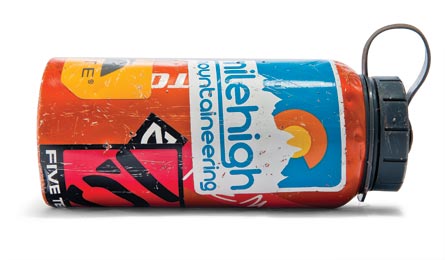Worst Nightmare: Man Down

'Water Bottle (iStockphoto)'
It could be a heart attack. The pinch under his left pec could be the first squeeze of massive cardiac failure. With only his naive little brother to help him, he could die here, in the jaws of the Grand Canyon. Matt knew his therapist at the VA would call this kind of thinking “catastrophizing.”
He tried to come up with other scenarios that were not worst-case. Maybe it was just a too-heavy pack pulling on his out-of-shape torso? Or it could be from the way he was braking with all his might against his trekking poles as he tried to lower his body over two-foot ledges. Matt took his eyes off his feet for a few seconds, sucked air, and looked out into the canyon. It was dead quiet and far more beautiful than he’d expected. And so damn big. Twenty miles wide and 5,000 feet deep—impossible to fathom until you were actually inside of it.
Jake was about 100 feet ahead of him, practically hopping down the rocks. They were here because it was on Jake’s bucket list. His brother had all these places to go before he turned 50. Grand Canyon was something like #10 out of 25. Matt couldn’t keep track. Nepal, Kilimanjaro, Alaska, Patagonia were also on the list. But Jake was just celebrating his 40th birthday on this trip so there was plenty of time. At least there was for someone as energetic and optimistic as Jake.
Matt was different from his brother. He would never tempt fate with a “things to do before I die” kind of pact. If he had a bucket list that he talked about the way Jake did, Matt was positive he would die in a dumb way (like a heart attack while hiking) before he got very far on the list. His therapist called this “survivor’s guilt.” Five years in Afghanistan had taken its toll. Fallen comrades were the hungry ghosts that followed Matt, sometimes appearing—broken, bloody, lifelike but always dying—in moments of stress.
Jake, who’d been training so he was in awesome bucket-list shape, had gotten so far ahead that Matt could no longer see him. Matt tried to quicken his pace, maybe be a little less over-cautious so he could catch his brother. His focus moved from the chest pain to just getting down the next three feet of trail. Slide and brake. Down and down.
Jake came into sight, and he was off the trail. He was doing a kind of walk/run scamper along the edge of a promontory on the Supai formation that jutted into the canyon like a shark’s fin.
“Check this out!” Jake shouted back at Matt. “You can see the river from here!”
Matt paused and sipped from his CamelBak. Jake stood still, looking down. Then the Grand Canyon moved. Just a small shift, as it had been doing for millennia. Sandwiched between Coconino and Redwall limestone, the sedimentary Supai was made from 300-million-year-old river deposits of ancient mud that were constantly sloughing off like a snake’s skin. The earth underneath Jake dropped away.
Matt watched as Jake tumbled 20 feet in a cloud of red dirt. He landed on his back and slid down the fine scree like a luge runner. Jake grabbed at cactus and scrub on the 50-degree talus slope, flailing his legs for something, anything, to stop gravity. But he kept sliding, down and down, over the lip of the Supai and out of view.
Matt heard crashing rock. A rapid fire pop, pop, pop echoed off the canyon walls. Strafing.
Matt tossed his trekking poles and ran and slid down the trail. He was laser-focused. He had done this before. Get the guy out alive. Matt reached the bottom of the Redwall and dropped his pack on the trail. He scrambled up a ravine, furiously pushing upward now, toward the point where he had last seen his brother. Giant boulders and brush pushed back at him, the thorns tearing at his fatigues.
The first thing Matt saw was Jake’s water bottle. It was at the bottom of a sheer limestone cliff. As Matt ran toward his brother, he already knew what he was going to see. The impact from falling 200 feet does the same thing to a body as stepping on an IED. It explodes. Shreds. Splatters.
His eyes cloudy with tears, Matt knelt down and put his hand on a sunken chest where both lungs had collapsed. He tried to count respirations, feel a heartbeat. There was a fist-sized gash around the liver that sucked air and pooled with blood. Clear fluid and blood dripped from the nose and ears. Another gash revealed the colon. “Hang on, buddy,” Matt said, almost reflexively. Hollow eyes stared back at him.
A raven passed overhead, casting a shadow. Matt shuddered.
“There you are!”
Matt looked in the direction of the voice and then his gaze drifted up to the top of the South Rim, 2,500 feet above. The craggy peaks of the Hindu Kush disappeared, the red rock of the Grand Canyon came back into focus.
“Thank god for that juniper bush!” said Jake, breathless from the search for his brother and covered with bloody scratches from his short tumble. Matt was kneeling over a boulder, his face wet with tears. “Where did you go, man?” Jake asked, picking up his intact water bottle from the rocks. “I thought I had lost you.”